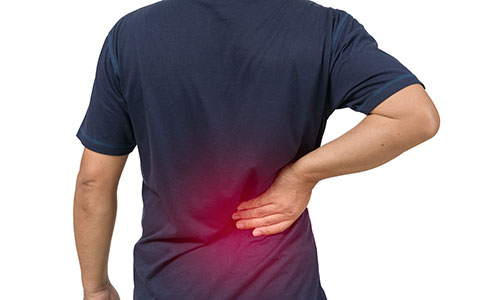SPINE PROBLEMS
Ayurveda can provide complementary approaches to managing slip disc (also known as a herniated or bulging disc) by focusing on pain relief, reducing inflammation, and promoting overall spine health. However, it’s important to note that Ayurvedic treatments should be used alongside conventional medical advice and under the guidance of a qualified Ayurvedic practitioner. Here are some Ayurvedic strategies for managing slip disc:

- Herbal Remedies:
- Ashwagandha: This adaptogenic herb has anti-inflammatory properties and can help reduce pain and inflammation associated with slip disc.
- Guggul: Guggul resin is known for its anti-inflammatory and analgesic properties and may be used to alleviate pain and inflammation in the affected area.
- Maharasnadi Kwath: An Ayurvedic herbal decoction containing ingredients like guggul, ashwagandha, and giloy, Maharasnadi Kwath can help reduce pain and inflammation.
DISC BULGE
Ayurveda offers holistic approaches to managing disc bulge, which is a condition where the soft inner portion of an intervertebral disc protrudes through the outer layer. These approaches focus on reducing pain, inflammation, and discomfort while promoting spinal health. However, it’s crucial to consult with a qualified Ayurvedic practitioner for personalized guidance, and Ayurvedic treatments should complement conventional medical advice. Here are some Ayurvedic strategies for managing disc bulge:
- Herbal Remedies:
- Ashwagandha: This adaptogenic herb has anti-inflammatory and analgesic properties, which can help reduce pain and inflammation associated with disc bulge.
- Guggul: Guggul resin is known for its anti-inflammatory and pain-relieving properties and may be used to alleviate discomfort.
- Maharasnadi Kwath: This Ayurvedic herbal decoction contains herbs like guggul, ashwagandha, and giloy and can help reduce pain and inflammation.
- External Treatments:
- Herbal Poultices (Lepa): Applying a warm herbal poultice to the affected area can help reduce pain and inflammation. Commonly used herbs include Nirgundi, Erand, and Rasna.
- Oil Massage (Abhyanga): Gentle massage of the affected area with warm Ayurvedic oils, such as Mahanarayan oil or Dhanvantaram oil, can help improve circulation and reduce pain.
- Dietary Recommendations:
- Anti-Inflammatory Diet: Consume foods that have anti-inflammatory properties, such as turmeric, ginger, garlic, and leafy greens. Avoid inflammatory foods like processed sugars and fried foods.
- Adequate Hydration: Staying well-hydrated is essential to maintain the health of spinal discs.
- Lifestyle Recommendations:
- Proper Posture: Maintain good posture while sitting, standing, and sleeping to prevent further strain on the spine.
- Rest and Sleep: Adequate rest and sleep are crucial for the body’s natural healing processes.
- Yoga and Stretching: Gentle yoga poses and stretches can help improve flexibility and alleviate pain. Poses like Cat-Cow, Cobra, and Child’s Pose may be beneficial.
- Weight Management: Maintain a healthy weight to reduce pressure on the spine and discs.
- Detoxification (Panchakarma):
- Panchakarma therapies, such as Abhyanga (oil massage), Swedana (steam therapy), and Basti (enema), may be recommended by an Ayurvedic practitioner to detoxify and rejuvenate the body.
CERVICAL COMPRESSION
Ayurveda can offer holistic approaches to managing cervical compression, which is a condition characterized by pressure on the spinal nerves in the neck region. Ayurvedic treatments aim to reduce pain and inflammation, improve mobility, and promote overall neck and spine health. However, it’s crucial to consult with a qualified Ayurvedic practitioner for personalized guidance, and Ayurvedic treatments should complement conventional medical advice. Here are some Ayurvedic strategies for managing cervical compression:
- Herbal Remedies:
- Ashwagandha: This adaptogenic herb has anti-inflammatory and analgesic properties that can help reduce pain and inflammation associated with cervical compression.
- Guggul: Guggul resin is known for its anti-inflammatory and pain-relieving properties and may be used to alleviate discomfort.
- Maharasnadi Kwath: An Ayurvedic herbal decoction containing herbs like guggul, ashwagandha, and giloy can help reduce pain and inflammation.
- External Treatments:
- Herbal Poultices (Lepa): Applying a warm herbal poultice to the affected area can help reduce pain and inflammation. Commonly used herbs include Nirgundi, Erand, and Rasna.
- Oil Massage (Abhyanga): Gentle massage of the neck and upper back with warm Ayurvedic oils, such as Mahanarayan oil or Dhanvantaram oil, can help improve circulation, reduce pain, and promote relaxation.

LUMBAR COMPRESSION
Ayurveda offers holistic approaches to managing lumbar compression, which is a condition characterized by pressure on the spinal nerves in the lower back (lumbar) region. Ayurvedic treatments aim to reduce pain and inflammation, improve mobility, and promote overall lumbar and spine health. However, it’s essential to consult with a qualified Ayurvedic practitioner for personalized guidance, and Ayurvedic treatments should complement conventional medical advice. Here are some Ayurvedic strategies for managing lumbar compression:
- Herbal Remedies:
- Ashwagandha: This adaptogenic herb has anti-inflammatory and analgesic properties that can help reduce pain and inflammation associated with lumbar compression.
- Guggul: Guggul resin is known for its anti-inflammatory and pain-relieving properties and may be used to alleviate discomfort.
- Maharasnadi Kwath: An Ayurvedic herbal decoction containing herbs like guggul, ashwagandha, and giloy can help reduce pain and inflammation.
- External Treatments:
- Herbal Poultices (Lepa): Applying a warm herbal poultice to the affected area can help reduce pain and inflammation. Commonly used herbs include Nirgundi, Erand, and Rasna.
- Oil Massage (Abhyanga): Gentle massage of the lower back with warm Ayurvedic oils, such as Mahanarayan oil or Dhanvantaram oil, can help improve circulation, reduce pain, and promote relaxation.
- Dietary Recommendations:
- Anti-Inflammatory Diet: Consume foods that have anti-inflammatory properties, such as turmeric, ginger, garlic, and leafy greens. Avoid inflammatory foods like processed sugars and fried foods.
- Adequate Hydration: Staying well-hydrated is essential to maintain the health of spinal discs and reduce stiffness.
- Lifestyle Recommendations:
- Proper Posture: Maintain good posture while sitting, standing, and sleeping to prevent further strain on the lower back and spine.
- Rest and Sleep: Adequate rest and sleep are crucial for the body’s natural healing processes.
- Gentle Lower Back Exercises: Specific exercises and stretches recommended by an Ayurvedic practitioner can help improve mobility and reduce muscle tension.
- Detoxification (Panchakarma):
- Panchakarma therapies, such as Abhyanga (oil massage), Swedana (steam therapy), and Basti (enema), may be recommended by an Ayurvedic practitioner to detoxify and rejuvenate the body.
SCIATICA

Ayurveda offers holistic approaches to managing sciatica, a condition characterized by pain radiating along the sciatic nerve, which runs from the lower back down through the buttocks and legs. Ayurvedic treatments aim to reduce pain, inflammation, and discomfort, improve mobility, and promote overall spine health. However, it’s essential to consult with a qualified Ayurvedic practitioner for personalized guidance, and Ayurvedic treatments should complement conventional medical advice. Here are some Ayurvedic strategies for managing sciatica:
Herbal Remedies:
- Ashwagandha: This adaptogenic herb has anti-inflammatory and analgesic properties that can help reduce pain and inflammation associated with sciatica.
- Guggul: Guggul resin is known for its anti-inflammatory and pain-relieving properties and may be used to alleviate discomfort.
- Maharasnadi Kwath: An Ayurvedic herbal decoction containing herbs like guggul, ashwagandha, and giloy can help reduce pain and inflammation.
NERVE COMPRESSION
Ayurveda offers holistic approaches to managing nerve compression, which can cause pain, tingling, numbness, or weakness due to pressure on a nerve. Ayurvedic treatments aim to reduce pain and inflammation, improve nerve function, and promote overall well-being. However, it’s essential to consult with a qualified Ayurvedic practitioner for personalized guidance, and Ayurvedic treatments should complement conventional medical advice. Here are some Ayurvedic strategies for managing nerve compression:
- Herbal Remedies:
- Ashwagandha: This adaptogenic herb has anti-inflammatory and analgesic properties that can help reduce pain and inflammation associated with nerve compression.
- Guggul: Guggul resin is known for its anti-inflammatory and pain-relieving properties and may be used to alleviate discomfort.
- Maharasnadi Kwath: An Ayurvedic herbal decoction containing herbs like guggul, ashwagandha, and giloy can help reduce pain and inflammation.
- External Treatments:
- Herbal Poultices (Lepa): Applying a warm herbal poultice to the affected area can help reduce pain and inflammation. Commonly used herbs include Nirgundi, Erand, and Rasna.
- Oil Massage (Abhyanga): Gentle massage of the affected area with warm Ayurvedic oils, such as Mahanarayan oil or Dhanvantaram oil, can help improve circulation, reduce pain, and promote relaxation.
- Dietary Recommendations:
- Anti-Inflammatory Diet: Consume foods that have anti-inflammatory properties, such as turmeric, ginger, garlic, and leafy greens. Avoid inflammatory foods like processed sugars and fried foods.
- Adequate Hydration: Staying well-hydrated is essential to maintain the health of nerves and reduce stiffness.
- Lifestyle Recommendations:
- Proper Posture: Maintain good posture while sitting, standing, and sleeping to prevent further strain on the affected nerve.
- Rest and Sleep: Adequate rest and sleep are crucial for the body’s natural healing processes.
- Gentle Exercises: Specific exercises and stretches recommended by an Ayurvedic practitioner can help improve nerve function and reduce muscle tension.
- Detoxification (Panchakarma):
- Panchakarma therapies, such as Abhyanga (oil massage), Swedana (steam therapy), and Basti (enema), may be recommended by an Ayurvedic practitioner to detoxify and rejuvenate the body.

